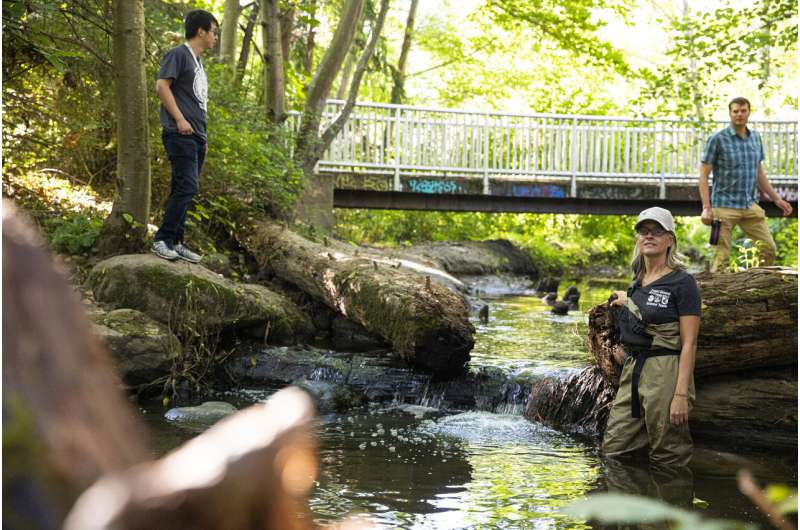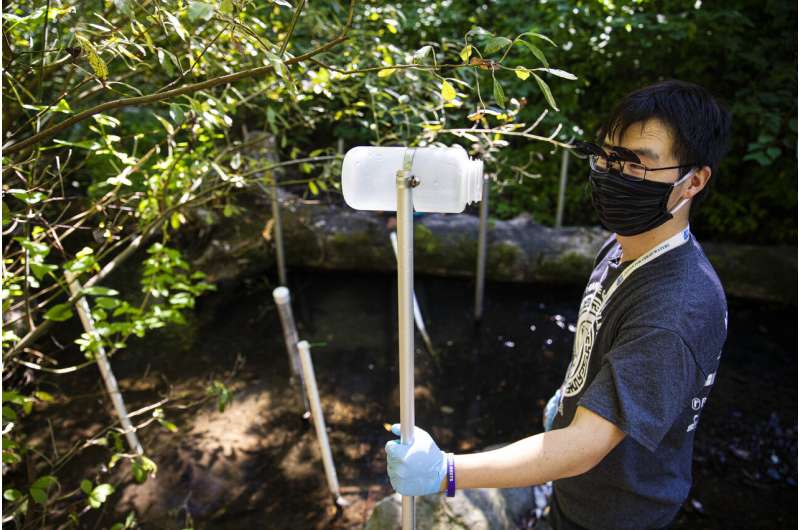Tire-related chemical is largely responsible for adult coho salmon deaths in urban streams

Every fall more than half of the coho salmon that return to Puget Sound's urban streams die before they can spawn. In some streams, all of them die. But scientists didn't know why.
Now a team led by researchers at the University of Washington Tacoma, UW and Washington State University Puyallup have discovered the answer. When it rains, stormwater flushes bits of aging vehicle tires on roads into neighboring streams. The killer is in the mix of chemicals that leach from tire wear particles: a molecule related to a preservative that keeps tires from breaking down too quickly.
This research was published Dec. 3 in Science.
"Most people think that we know what chemicals are toxic and all we have to do is control the amount of those chemicals to make sure water quality is fine. But, in fact, animals are exposed to this giant chemical soup and we don't know what many of the chemicals in it even are," said co-senior author Edward Kolodziej, an associate professor in both the UW Tacoma Division of Sciences & Mathematics and the UW Department of Civil & Environmental Engineering.
"Here we started with a mix of 2,000 chemicals and were able to get all the way down to this one highly toxic chemical, something that kills large fish quickly and we think is probably found on every single busy road in the world."
Coho salmon are born in freshwater streams. After spending the first year of their lives there, these fish make the epic journey out to sea where they live out most of their adult lives. A few—about 0.1%—return to their original streams to lay their eggs, or spawn, before dying. But researchers started noticing that, especially after a big rain, returning salmon were dying before they could spawn. The search for the coho-killer started with investigating the water quality of the creeks, a multi-agency effort led by NOAA-Fisheries and including the U.S. Fish and Wildlife Services, King County, Seattle Public Utilities and the Wild Fish Conservancy.
"We had determined it couldn't be explained by high temperatures, low dissolved oxygen or any known contaminant, such as high zinc levels," said co-senior author Jenifer McIntyre, an assistant professor at WSU's School of the Environment, based in Puyallup. "Then we found that urban stormwater runoff could recreate the symptoms and the acute mortality. That's when Ed's group reached out to see if they could help us understand what was going on chemically."
First the team narrowed down what in stormwater runoff could be behind the symptoms. The researchers compared water from creeks where salmon were seen dying to look for common trends. All creek samples contained a chemical signature associated with tire wear particles. In addition, a study led by McIntyre found that a solution made from tire wear particles was highly toxic to salmon.
But tire wear particles are a mixture of hundreds of different chemicals, so the team had a challenge ahead: How to find the culprit?
The researchers started by sectioning the tire wear particle solution according to different chemical properties, such as removing all metals from the solution. Then they tested the different solutions to see which ones were still toxic to salmon in the lab. They repeated this process until only a few chemicals remained, including one that appeared to dominate the mixture but didn't match anything known.
"There were periods last year when we thought we might not be able to get this identified. We knew that the chemical that we thought was toxic had 18 carbons, 22 hydrogens, two nitrogens and two oxygens. And we kept trying to figure out what it was," said lead author Zhenyu Tian, a research scientist at the Center for Urban Waters at UW Tacoma. "Then one day in December, it was just like bing! in my mind. The killer chemical might not be a chemical directly added to the tire, but something related."
Tian searched a list of chemicals known to be in tire rubber for anything that might be similar to their unknown—give or take a few hydrogens, oxygens or nitrogens—and found something called 6PPD, which is used to keep tires from breaking down too quickly.
"It's like a preservative for tires," Tian said. "Similar to how food preservatives keep food from spoiling too quickly, 6PPD helps tires last by protecting them from ground-level ozone."
Ozone, a gas created when pollutants emitted by cars and other chemical sources react in the sunlight, breaks the bonds holding the tire together. 6PPD helps by reacting with ozone before it can react with the tire rubber, sparing the tires.

But when 6PPD reacts with ozone, the researchers found that it was transformed into multiple chemicals, including 6PPD-quinone (pronounced "kwih-known"), the toxic chemical that is responsible for killing the salmon.
This chemical is not limited to the Puget Sound region. The team also tested roadway runoff from Los Angeles and urban creeks near San Francisco, and 6PPD-quinone was present there as well. This finding is unsurprising, the researchers said, because 6PPD appears to be used in all tires and tire wear particles are likely present in creeks near busy roads across the world.
Now that 6PPD-quinone has been identified as the "smoking gun" behind coho death in freshwater streams, the team can start to understand why this chemical is so toxic.
"How does this quinone lead to toxicity in coho? Why are other species of salmon, such as chum salmon, so much less sensitive?" McIntyre asked. "We have a lot to learn about which other species are sensitive to stormwater or 6PPD-quinone within, as well as outside, of the Puget Sound region."
One way to protect salmon and other creatures living in the creeks is to treat stormwater before it hits the creeks. But, while tests have shown that there are effective environmentally friendly stormwater technologies for removing 6PPD-quinone, it would be almost impossible to build a treatment system for every road, the team added.
Another option is to change the composition of the tires themselves to make them "salmon-safe."
"Tires need these preservative chemicals to make them last," Kolodziej said. "It's just a question of which chemicals are a good fit for that and then carefully evaluating their safety for humans, aquatic organisms, etc. We're not sure what alternative chemical we would recommend, but we do know that chemists are really smart and have many tools in their toolboxes to figure out a safer chemical alternative."
More information: Z. Tian el al., "A ubiquitous tire rubber-derived chemical induces acute mortality in coho salmon," Science (2020). science.sciencemag.org/lookup/ … 1126/science.abd6951
Journal information: Science
Provided by University of Washington

















